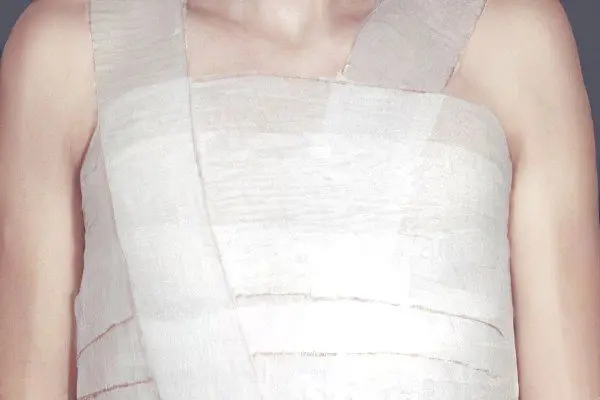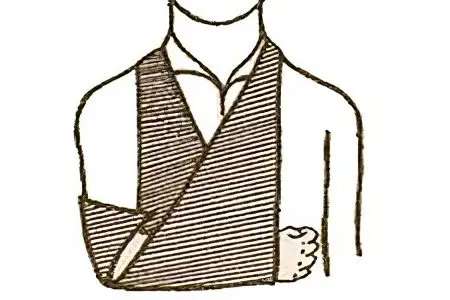Contents

A fracture is an injury to a bone with a violation of its integrity. The human skeleton consists of a variety of bones: long, short, flat, tubular, and many others. Their structure and location in the body is not accidental. Each bone is as strong and light as possible, able to withstand incredible loads. But situations often arise when a certain force acts on the bone, which exceeds its strength. In this case, a fracture occurs.
There are three types of rib fractures: fissure, subperiosteal fracture and complete rib fracture. They are listed in order of increasing severity. Most often there is a fracture of 5 – 8 pairs of ribs. 1-4 pairs are well protected by the collarbone, as well as a powerful shoulder and chest muscle corset, and 9-12 pairs of ribs are less prone to injury due to the fact that they mostly consist of a unique elastic cartilage.
Bandaging for broken ribs
A bandage is an aseptic material that closes a wound or other injured area. When the ribs are fractured, three types of dressings are used: antiseptic, occlusive and immobilizing. An antiseptic dressing is applied to open wounds. It will prevent further infection of the wound. Sometimes, with fractures of the ribs, a fragment of bone breaks through the tissues and an open wound is formed through which air enters the pleural cavity. To avoid this, a special occlusive dressing is applied.
Almost always, a special immobilizing bandage is applied to ensure immobility and rest. Let us consider in more detail how all these types of dressings are applied.
General rules for applying bandages for fractured ribs
The person who applies the dressing should, if possible, be placed face to face with the victim in order to see his reaction (pain or deterioration). Position the victim in a comfortable position for him, try to immobilize the part of the body on which the bandage is applied as much as possible. The size of the sterile bandage should correspond to the part of the body. For a finger, a bandage from 2 to 5 cm wide is suitable, and for the torso, you need to pick up a bandage from 14 to 16 cm wide.
The bandage should always be applied from the intact area to the wound, and from left to right. The sterile bandage itself should be in the right hand. He very gently rolls over the surface of the wound. The bandage should overlap the previous layer by at least half. When imposing, follow the accuracy of applying the bandage. There should be no significant folds and pinches that can disrupt blood and lymph circulation.
Antiseptic dressing
Antiseptic dressings are dry and wet. But when providing first aid, an antiseptic dry bandage is more often used. First you need to examine the wound and remove foreign bodies from its surface, if any. It is not necessary to remove specks, tissue remnants, fragments and other things from the wound. The same piece of clothing, located deep in the wound, can compress a blood vessel. And if you pull it out, then heavy bleeding can begin. These can be pieces of clothing, remnants of soil or metal (it all depends on the environment in which the injury occurred).
Next, several layers of sterile gauze soaked in an antiseptic solution should be applied to the wound. It can be a solution of suleyma or iodoform. Dried gauze is sprinkled with streptocide. The gauze is covered with a wide layer of hygroscopic cotton wool and the structure is fixed with a sterile bandage or adhesive tape of a suitable size.
Occlusive dressing
Open pneumothorax (accumulation of air in the pleura) often accompanies a fracture of the ribs. The main thing is to prevent air from entering the pleural cavity. For this, a special occlusive dressing is applied. To do this, the skin around the wound is liberally lubricated with petroleum jelly and put on top of an oilcloth, a regular plastic bag or other similar material that does not allow air to pass through at all. Cover the wound with a bandage and 5-10 cm around it. After that, a thick layer of ordinary cotton wool is applied and tightly bandaged.
Immobilizing bandage

When the ribs are fractured, a circular bandage is applied. To apply such a circular bandage, take the bandage in your right hand, hold the beginning of the bandage with your left hand. The beginning of the bandage is applied obliquely in order to carefully fix the first turns of the bandage. Then the first turn is carefully made around the torso of the victim (initially, the tip of the bandage remains free). Next, the tip of the bandage is bent and a second round is made.
After fixing the bandage, a sterile bandage is then applied to the required area. Do not forget, the bandage should always overlap the previous turn by at least half. With fractures of the ribs, there are several features of applying a bandage. Before starting bandaging, the victim must necessarily exhale the air. At the moment of inspiration, the application of the bandage always stops, and the free end of the bandage is slightly stretched.
If you suspect that a person has a broken rib, call an ambulance first. And only then provide first aid to the victim.









